WSN-SES/MB: System Entity Structure and Model Base Framework for Large-Scale Wireless Sensor Networks
Abstract
:1. Introduction
- Applying the SES/MB for synthesizing the structure and models and automating the complicated synthesizing process of WSN modeling construction;
- Saving time and cost in synthesizing various models by proposing a novel transformation process;
- Achieving efficiency of the WSN-SES/MB framework with a new pruning algorithm in our transformation process;
- Increasing diversity of synthesized simulation models by introducing the WSN-SES/MB framework;
- Facilitating the modeling and simulation of large-scale WSNs with all of the above.
2. WSN Simulators
3. SES/MB Framework
3.1. SES and PES Bases
- E: set of entities;
- A: set of aspects;
- S: set of specialization;
- : aspect relationships;
- : specialization relationship;
- : couplings attached to aspects;
- : selection rules attached to specializations and multiple-decomposition.
- E = {ABC, AB, CS, A, B, C};
- A = {A-dec, cs-mdec};
- S = {ab-spec};
- Asp = {(ABC, abc-dec, {AB, CS}), (CS, cs-mdec, {C})};
- Spec = {(AB, ab-spec, {A, B})};
- Coup = {(abc-dec, {(AB.out, CS.in), (CS.out, AB.in)}), (cs-mdec, {(CS.in, C.in), (C.out, CS.out)})};
- Rules = {(ab-spec, {A, B}), (cs-mdec, {selection of kernel-models, number of entities})}.
- E = {ABC, CS, A, C};
- A = {A-dec, cs-mdec};
- Asp = {(ABC, abc-dec, {A, CS}), (CS, cs-mdec, {C}, {broadcast-models, 10})};
- Coup = {(abc-dec, {(A.out, CS.in), (CS.out, A.in)}), (cs-mdec, {(CS.in, C.in), (C.out, CS.out)})}.
3.2. Model Base
4. WSN-SES/MB Framework
4.1. Overview
- SES base: This base contains the entity structures of the WSNs. The entity structures show the components of the WSNs hierarchically in various trees;
- Proposed Pruning: Our pruning algorithm selects entities from an SES tree for generating a PES and configures a sensor network’s environment parameters;
- PES base: This base includes pruned entity structures of the WSNs. Each entity structure contains the environment parameters;
- Model base: Atomic DEVS models defined in this base are entities corresponding to the leaf of the SES and PES trees. These atomic models represent the behavioral and procedural characteristics of the sensor network. The models are synthesized to generate the final simulation model;
- Simulation Model: This simulation model is the result of our framework, which is finally created by the structural representation, the network’s parameters, and the behavioral models.
4.2. Entity Structures
4.2.1. SES Base
- E = {EF-WSN, WSN, EF, BS, SENSORS, SENSOR, GENR, TRANSD};
- A = {ef-wsn-dec, wsn-dec, ef-dec, sensor-mdec};
- S = { };
- Asp = {(EF-WSN, ef-wsn-dec, {WSN, EF}), (WSN, wsn-dec, {BS, SENSORS}), (SENSORS, sensors-mdec, {SENSOR}), (EF, ef-dec, {GENR, TRANSD})};
- Spec = {};
- Coup = {(ef-wsn-dec, {(EF.out, WSN.in), (WSN.out, ef.in)}), (wsn-mdec, {(WSN.in, SENSORS.in), (BS.bs_out, WSN.out), (SENSORS.out, BS.packet_in}), sensors-mdec, {(SENSORS.in, SENSOR.event_in), (SENSOR.packet_out, SENSOR.packet_in), (SENSOR.sensor_out, SENSORS.out)}, ef-dec, {(EF.in, TRANSD.solved), (GENR.out, EF.out), (TRANSD.out, EF.result), (TRANSD.out, GENR.stop)}};
- Rules = {(sensors-mdec, {sub-model selection of kernel-models, number of the entity, {sensor filed size, BS location}})}.
4.2.2. Proposed Pruning Algorithm
| Algorithm 1 Pruning of WSN-SES/MB |
| 1: while node of all nodes of SES 2: if node == specialization then 3: Select an entity among all child entities; 4: end if 5: 6: if node == multiple-decomposition then 7: Select a sub-model of DEVS kernel-models; 8: Input number of members 9: 10: if sub-model == ‘broadcast-model’ then 11: Input sensorFieldSize(X, Y); 12: Input bsLocation(X, Y); 13: end if 14: end if 15: end while |
4.2.3. PES Base
- DEVS Kernel’s Sub-model: broadcast-model;
- Number of members: 200;
- Sensor field size: 500 × 500 m2;
- BS Location: 250, 250.
- E = {EF-WSN, WSN, EF, BS, SENSORS, SENSOR, GENR, TRANSD};
- A = {ef-wsn-dec, wsn-dec, ef-dec, sensor-mdec};
- Asp = {(EF-WSN, ef-wsn-dec, {WSN, EF}), (WSN, wsn-dec, {BS, SENSORS}), (SENSORS, sensors-mdec, {CS}, {broadcast-model, 200, {(500, 500), (250, 250)}}), (EF, ef-dec, {GENR, TRANSD})};
- Coup = {(ef-wsn-dec, {(EF.out, WSN.in), (WSN.out, ef.in)}), (wsn-mdec, {(WSN.in, SENSORS.in), (BS.bs_out, WSN.out), (SENSORS.out, BS.packet_in}), sensors-mdec, {(SENSORS.in, SENSOR.event_in), (SENSOR.packet_out, SENSOR.packet_in), (SENSOR.sensor_out, SENSORS.out)}, ef-dec, {(EF.in, TRANSD.solved), (GENR.out, EF.out), (TRANSD.out, EF.result), (TRANSD.out, GENR.stop)}}.
4.3. Model Base
- SENSOR model (Figure 4a): A sensor model has two roles in a field: (1) a source model and (2) an intermediate model. (1) The source model receives events from an input port event_in and generates a report (state transition: passive→sensing). The report is forward to the next SENSOR through an output port report_out (state transition: sensing→forwarding). (2) The intermediate model receives a report from its source or previous model through an input port report_in (state transition: passive→sensing). This model analyzes the report data and transmits it to the next SENSOR through the output port report_out (state transition: sensing→forwarding). If the next forwarding node is a BS, this model forwards the report through an output port sn_out;
- BS model (Figure 4b): This model receives the report sent from SENSOR through an input port report_in (state transition: passive→receiving). After the model analyzes the report’s data (state transition: receiving→analyzing), it notices the report result through an output port out;
- GENR model (Figure 4c): This model randomly generates events in the active state. The event message is delivered to SENSOR and TRANSD through an output port out. When a message is received form TRANSD through an input port stop, the event is no longer generated (state transition: active→passive);
- TRANSD model (Figure 4d): This model collects event data generated from GENR through an input port ariv and result information from the report received from BS through a port solved. The model evaluates the simulation model through the collected analysis results. When the simulation observation time is over, a stop message is output through a port out and this message is delivered to GENR (state transition: active→stop).
4.4. Simulation Model
5. Simulation Results
6. Conclusions and Future Work
- Application of the SES/MB to synthesize the structure and models and automate the complicated synthesizing process of WSN modeling construction. Our WSN-SEN/MB framework automatically synthesizes the structure and simulation models through the transformation process;
- Reduced cost and time when synthesizing various sensor networks by proposing a novel transformation process. In the propsoed framework, our transformation process effectively reduces the cost and time of automatic synthesis through the proposed pruning algorithm;
- Efficiency in the WSN-SES/MB framework with our pruning algorithm. The proposed pruning algorithm configures environment parameters of the sensor network, such as the number of sensors, the field size, and the BS location. These parameters are used during the synthesis of the DEVS model;
- Increased diversity of synthesized simulation models. The WSN-SES/MB framework generates simulation models using the entity structures within the parameters and the atomic DEVS models;
- The modeling and simulation of large-scale WSNs. The proposed framework enables the construction of large-scale WSNs through various environment parameters.
Author Contributions
Funding
Institutional Review Board Statement
Informed Consent Statement
Data Availability Statement
Conflicts of Interest
References
- Akyildiz, I.F.; Su, W.; Sankarasubramaniam, Y.; Cayirci, E. Wireless sensor networks: A survey. Comput. Netw. 2002, 38, 393–422. [Google Scholar] [CrossRef] [Green Version]
- Akkaya, K.; Younis, M. A survey on routing protocols for wireless sensor networks. Ad Hoc Netw. 2005, 3, 325–349. [Google Scholar] [CrossRef] [Green Version]
- Landaluce, H.; Arjona, L.; Perallos, A.; Falcone, F.; Angulo, I.; Muralter, F. A Review of IoT Sensing Applications and Challenges Using RFID and Wireless Sensor Networks. Sensors 2020, 20, 2495. [Google Scholar] [CrossRef] [PubMed]
- Yick, J.; Mukherjee, B.; Ghosal, D. Wireless sensor network survey. Comput. Netw. 2008, 52, 2292–2330. [Google Scholar] [CrossRef]
- Fu, X.; Yao, H.; Yang, Y. Modeling Cascading Failures for Wireless Sensor Networks With Node and Link Capacity. IEEE Trans. Veh. Technol. 2019, 68, 7828–7840. [Google Scholar] [CrossRef]
- Narayanan, R.P.; Sarath, T.V.; Vineeth, V.V.; Narayanan, R.P. Survey on Motes Used in Wireless Sensor Networks: Performance & Parametric Analysis. Wirel. Sens. Netw. 2016, 8, 51–60. [Google Scholar]
- Fu, X.; Yao, H.; Yang, Y. Cascading failures in wireless sensor networks with load redistribution of links and nodes. Ad Hoc Netw. 2019, 93, 101900. [Google Scholar] [CrossRef]
- Minakov, I.; Passerone, R.; Rizzardi, A.; Sicari, S. A comparative study of recent wireless sensor network simulators. ACM Trans. Sens. Netw. 2016, 12, 1–39. [Google Scholar] [CrossRef]
- Nam, S.M.; Cho, T.H. Context-Aware Architecture for Probabilistic Voting-based Filtering Scheme in Sensor Networks. IEEE Trans. Mob. Comput. 2017, 16, 2751–2763. [Google Scholar] [CrossRef]
- Nam, S.M.; Cho, T.H. Discrete event simulation–based energy efficient path determination scheme for probabilistic voting–based filtering scheme in sensor networks. Int. J. Distrib. Sens. Netw. 2020, 16, 1–13. [Google Scholar] [CrossRef]
- Sarkar, A.; Murugan, T.S. Routing protocols for wireless sensor networks: What the literature says? Alex. Eng. J. 2016, 55, 3173–3183. [Google Scholar] [CrossRef] [Green Version]
- Nam, S.M.; Cho, T.H. A fuzzy rule-based path configuration method for LEAP in sensor networks. Ad Hoc Netw. 2015, 31, 63–79. [Google Scholar] [CrossRef]
- Zeigler, B.P. Hierarchical, modular discrete-event modelling in an object-oriented environment. Simulation 1987, 49, 219–230. [Google Scholar] [CrossRef]
- Zeigler, B.P. Object-Oriented Simulation with Hierarchical, Modular Models: Intelligent Agents and Endomorphic Systems; Academic Press: San Diego, CA, USA, 2014. [Google Scholar]
- Park, H.C.; Lee, W.B.; Kim, T.G. RASES: A database supported framework for structured model base management. Simul. Pract. Theory 1997, 5, 289–313. [Google Scholar] [CrossRef]
- Levis, P.; Welsh, N.L.M.; Culler, D. TOSSIM: Accurate and scalable simulation of entire TinyOS applications. In Proceedings of the First ACM Conference on Embedded Networked, Los Angeles, CA, USA, 5–7 November 2003; pp. 126–137. [Google Scholar]
- Titzer, B.L.; Lee, D.K.; Palsberg, J.; Titzer, J.; Lee, B.L.; Palsberg, D.K. Avrora: Scalable sensor network simulation with precise timing. In Proceedings of the 2005 4th International Symposium on Information Processing in Sensor Networks, Boise, ID, USA, 15 April 2005; pp. 477–482. [Google Scholar]
- NS-3. Available online: https://www.nsnam.org/ (accessed on 11 February 2020).
- OMNeT++. Available online: https://omnetpp.org/ (accessed on 11 February 2020).
- Schmidt, A.; Durak, U.; Pawletta, T. Model-based testing methodology using system entity structures for MATLAB/Simulink models. Simulation 2016, 92, 729–746. [Google Scholar] [CrossRef]
- Rozenblit, J.W.; Zeigler, B.P. Concepts for knowledge-based system design environments. In Proceedings of the 17th Conference on Winter Simulation, New York, NY, USA, 11–13 December 1985; pp. 223–231. [Google Scholar]
- Zeigler, B.P. Multifacetted Modelling and Discrete Event Simulation; Academic Press Professional, Inc.: Cambridge, MA, USA, 1984. [Google Scholar]
- Zeigler, B.P.; Kim, T.G.; Praehofer, H. Theory of Modeling and Simulation; Academic Press: Cambridge, MA, USA, 2000. [Google Scholar]
- Zeigler, B.P.; Hammonds, P.E. Modeling and Simulation-Based Data Engineering: Introducing Pragmatics into Ontologies for Net-Centric Information Exchange; Elsevier: Amsterdam, The Netherlands, 2007. [Google Scholar]
- Zeigler, B.P.; Cho, T.H.; Rozenblit, J.W. A knowledge-based simulation environment for hierarchical flexible manufacturing. IEEE Trans. Syst. Man Cybern. Part A Syst. Hum. 1996, 26, 81–90. [Google Scholar] [CrossRef]
- Kim, T.G.; Zeigler, B.P. DEVS formalism: Hierarchical, Modular Systems Specification in an Object Oriented Framework. In Proceedings of the 19th Conference on Winter Simulation, Atlanta, GA, USA, 14–16 December 1987; pp. 559–566. [Google Scholar]
- Simon, G.; Volgyesi, P.; Maroti, M.; Ledeczi, A. Simulation-based optimization of communication protocols for large-scale wireless sensor networks. In Proceedings of the 2003 IEEE Aerospace Conference Proceedings, Big Sky, MT, USA, 8–15 March 2003. [Google Scholar]
- Prowler: Probabilistic Wireless Network Simulator. Available online: https://www.isis.vanderbilt.edu/projects/nest/prowler/ (accessed on 25 February 2020).
- Ledeczi, A.; Maroti, M.; Bartok, I. SIESTA—Simple NEST Application Simulator Siesta v1.0; Institute for Software Integrated Systems: Nashville, TN, USA, 2001. [Google Scholar]
- NEST Project. Available online: http://webs.cs.berkeley.edu/ (accessed on 8 March 2017).
- Sundresh, A.G.; Kim, S. SENS: A Sensor, Environment and Network Simulator. In Proceedings of the 37th Annual Simulation Symposium, Arlington, VA, USA, 18–22 April 2004; pp. 221–228. [Google Scholar]
- Polley, J.S.; Blazakis, J.; McGee, D.; Rusk, J.; Baras, D. ATEMU: A fine-grained sensor network simulator. In Proceedings of the 2004 First Annual IEEE Communications Society Conference on Sensor and Ad Hoc Communications and Networks, Santa Clara, CA, USA, 4–7 October 2004; pp. 145–152. [Google Scholar]
- Baronti, P.; Pillai, P.; Chook, V.W.C.; Chessa, S.; Gotta, A.; Hu, Y.F. Wireless sensor networks: A survey on the state of the art and the 802.15.4 and ZigBee standards. Comput. Commun. 2007, 30, 1655–1695. [Google Scholar] [CrossRef]
- Mehdi, K.; Lounis, M.; Bounceur, A.; Kechadi, T. CupCarbon: A multi-agent and discrete event Wireless Sensor Network design and simulation tool. In Proceedings of the 7th International ICST Conference on Simulation Tools and Techniques; ACM: New York, NY, USA, 2014; pp. 126–131. [Google Scholar]
- CupCarbon. Available online: http://cupcarbon.com/ (accessed on 1 August 2020).
- The Network Simulator-ns-2. Available online: https://www.isi.edu/nsnam/ns/ (accessed on 1 August 2017).
- Carneiro, G.; Fortuna, P.; Ricardo, M. FlowMonitor—A network monitoring framework for the Network Simulator 3 (NS-3). In 2nd International ICST International Workshop on Network Simulation Tools; ACM: New York, NY, USA, 2012. [Google Scholar]
- Wireshark. Available online: https://www.wireshark.org/ (accessed on 25 February 2020).
- Zarrad, A.; Alsmadi, I. Evaluating network test scenarios for network simulators systems. Int. J. Distrib. Sens. Netw. 2017, 13, 1–17. [Google Scholar] [CrossRef]
- Shnayder, V.; Hempstead, M.; Chen, B.; Allen, G.W.; Welsh, M. Simulating the power consumption of large-scale sensor network applications. In Proceedings of the 2nd International Conference on Embedded Networked Sensor Systems; ACM: New York, NY, USA, 2004. [Google Scholar]
- Michael, D.; Levis, P.; Joki, A.; Brewer, E.; Culler, D. Tython: A Dynamic Simulation Environment for Sensor Networks; Technical Report UCB/CSD-05-1372; EECS Department, University of California Berkeley: Berkeley, CA, USA, 2005. [Google Scholar]
- Al-Karaki, J.N.; Kamal, E.A. Routing techniques in wireless sensor networks: A survey. IEEE Wirel. Commun. 2004, 11, 6–28. [Google Scholar] [CrossRef] [Green Version]
- Singh, S.K.; Singh, M.; Singh, D.K. Routing Protocols in Wireless Sensor Networks—A Survey. Int. J. Comput. Sci. Eng. Surv. 2010, 1, 63–83. [Google Scholar] [CrossRef]
- Antoine-Santoni, T.; Santucci, J.F.; de Gentili, E.; Costa, B. DEVS-WSN: A discrete event approach for Wireless Sensor Network simulation. In Proceedings of the 2008 IEEE/ACS International Conference on Computer Systems and Applications, Doha, Qatar, 31 March–4 April 2008; pp. 3189–3200. [Google Scholar]
- Wainer, G. CD++: A toolkit to develop DEVS models. Softw. Pract. Exp. 2002, 32, 1261–1306. [Google Scholar] [CrossRef]
- Wainer, G.A.; Giambiasi, N. Application of the Cell-DEVS Paradigm for Cell Spaces Modelling and Simulation. Simulation 2001, 76, 22–39. [Google Scholar] [CrossRef]
- Wainer, G.; Giambiasi, N. Timed Cell-DEVS: Modeling and Simulation of Cell Spaces. In Discrete Event Modeling and Simulation Technologies; Springer: Berlin/Heidelberg, Germany, 2001. [Google Scholar]
- Nam, S.M. DEVS-C++. Github. Available online: https://github.com/sumannam/DEVS-Cpp (accessed on 1 November 2020).
- Nam, S.M.; Cho, T.H.; Kim, H.J. Modeling and Simulation for using Multiple Routing Protocols in Wireless. Korea Soc. Simul. 2020, 29, 73–82. [Google Scholar]
- Hagendorf, O.; Pawletta, T. Framework for a Structure and Parameter Optimization of Discrete-Event Systems; CRC Press: Boca Raton, FL, USA, 2011. [Google Scholar]
- Folkerts, H.; Pawletta, T.; Deatcu, C.; Hartmann, S. Python-based eSES/MB Framework: Model Specification and Automatic Model Generation for Multiple Simulators. SNE Simul. Notes Eur. 2019, 29, 207–215. [Google Scholar] [CrossRef]
- Ye, F.; Luo, H.; Lu, S.; Zhang, L. Statistical en-route filtering of injected false data in sensor networks. IEEE J. Sel. Areas Commun. 2005, 23, 839–850. [Google Scholar] [CrossRef]
- Hagendorf, O.; Pawletta, T.; Larek, R. An approach to simulation-based parameter and structure optimization of MATLAB/Simulink models using evolutionary algorithms. Simulation 2013, 89, 1115–1127. [Google Scholar] [CrossRef]
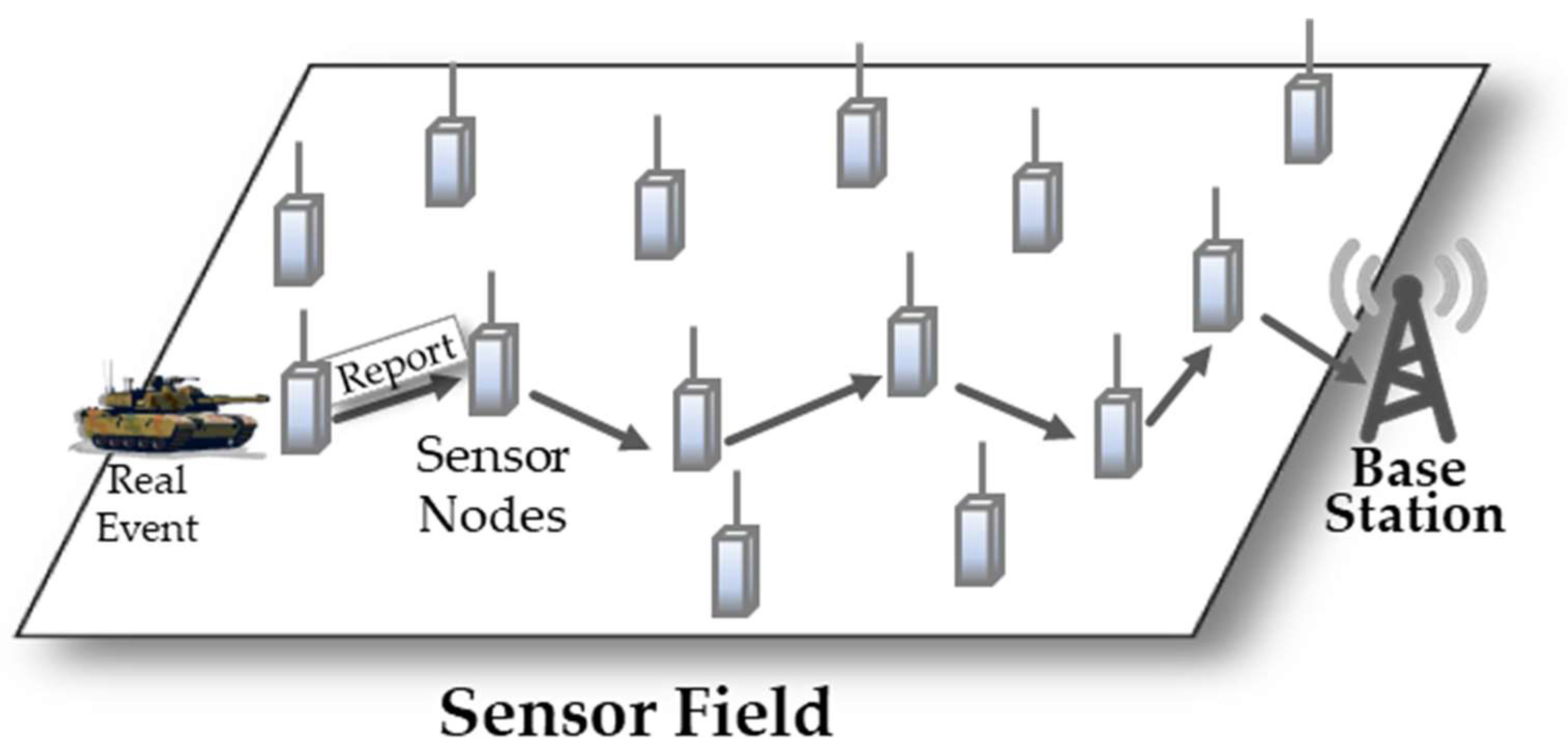
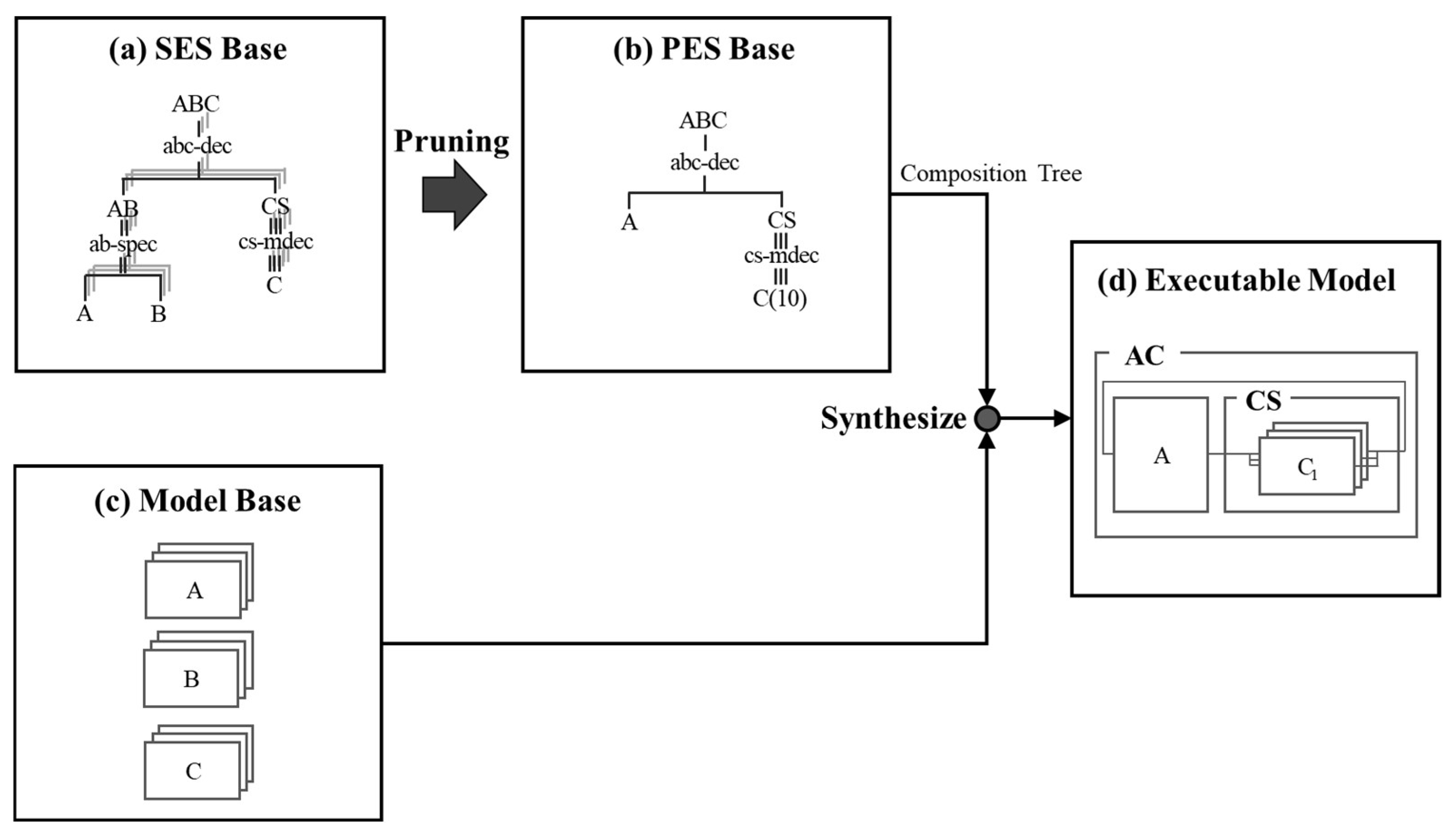
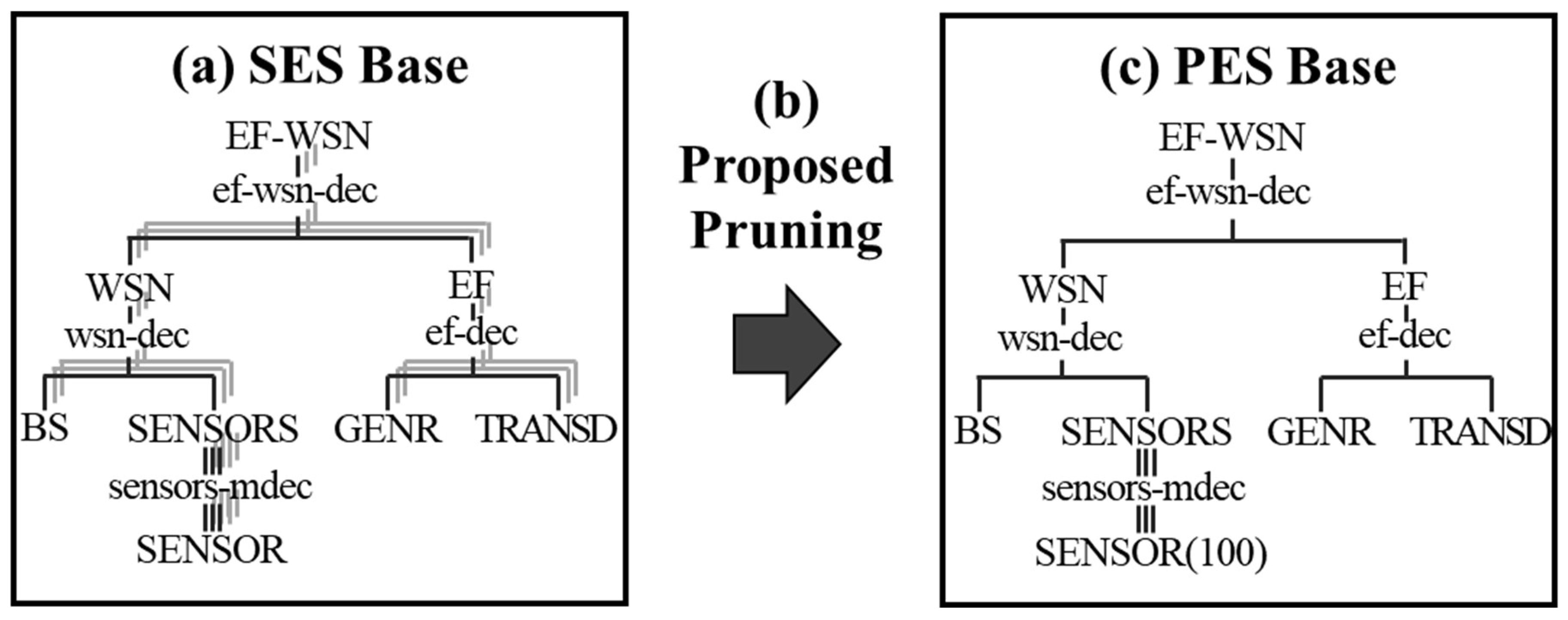
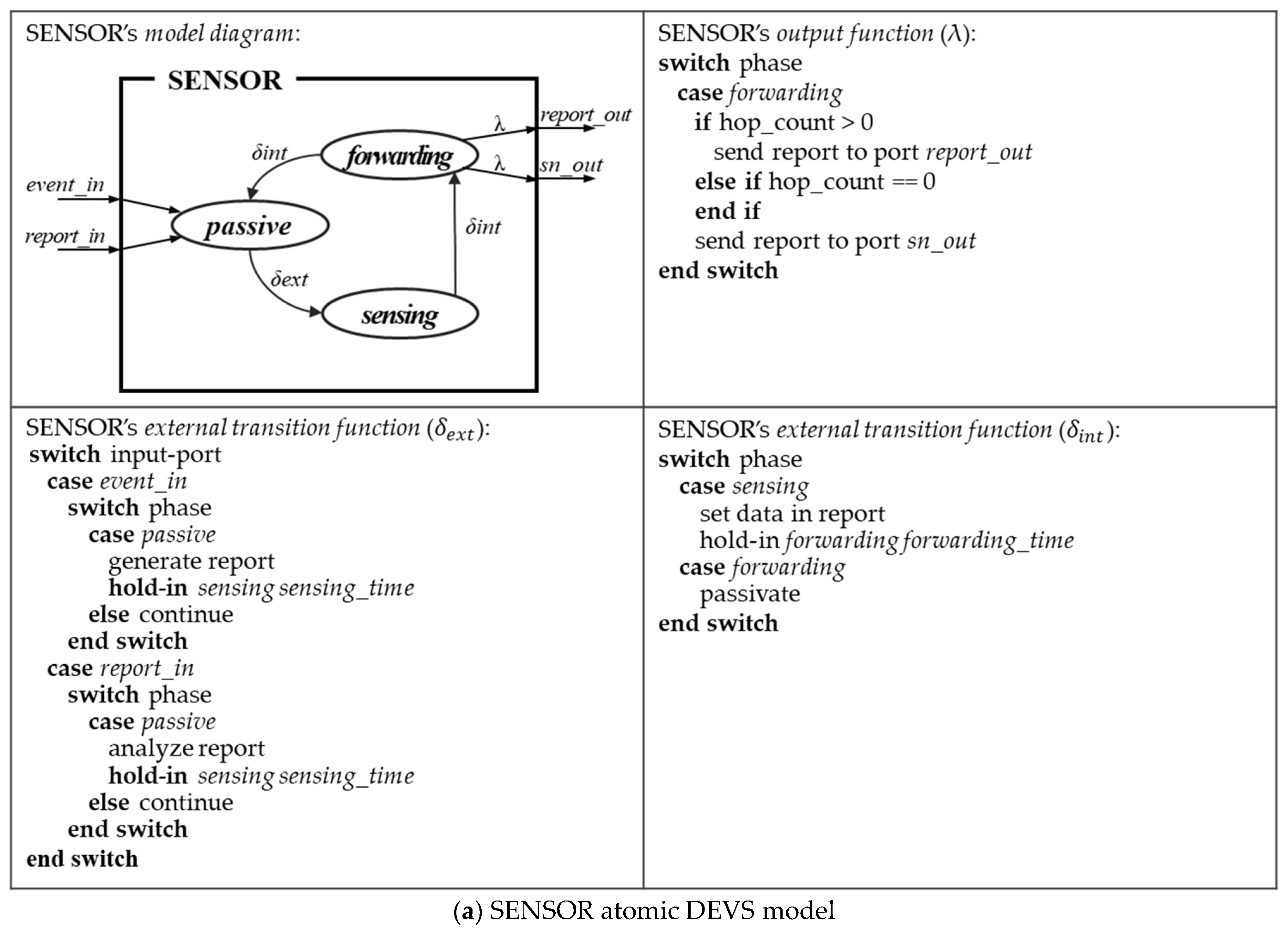
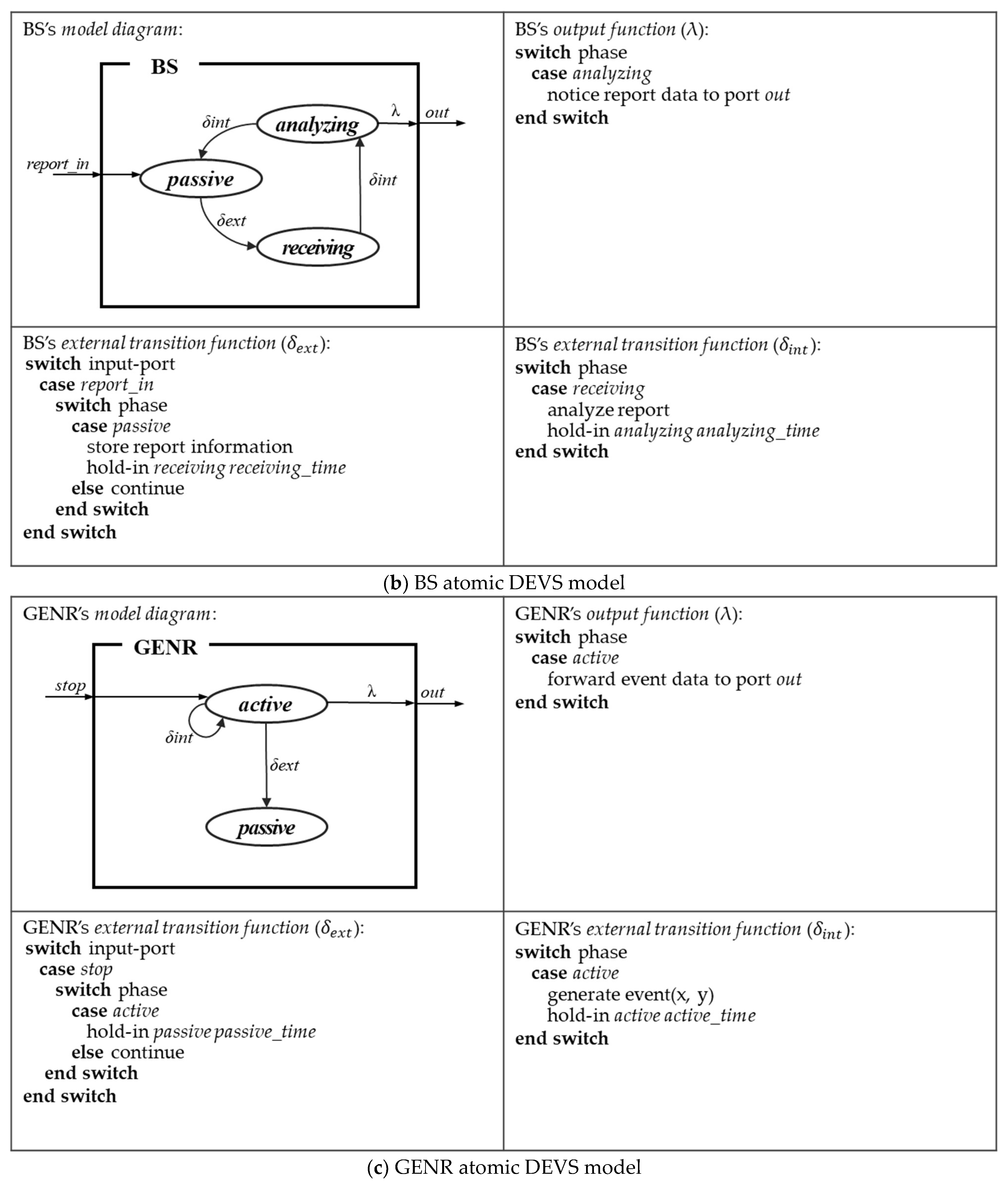
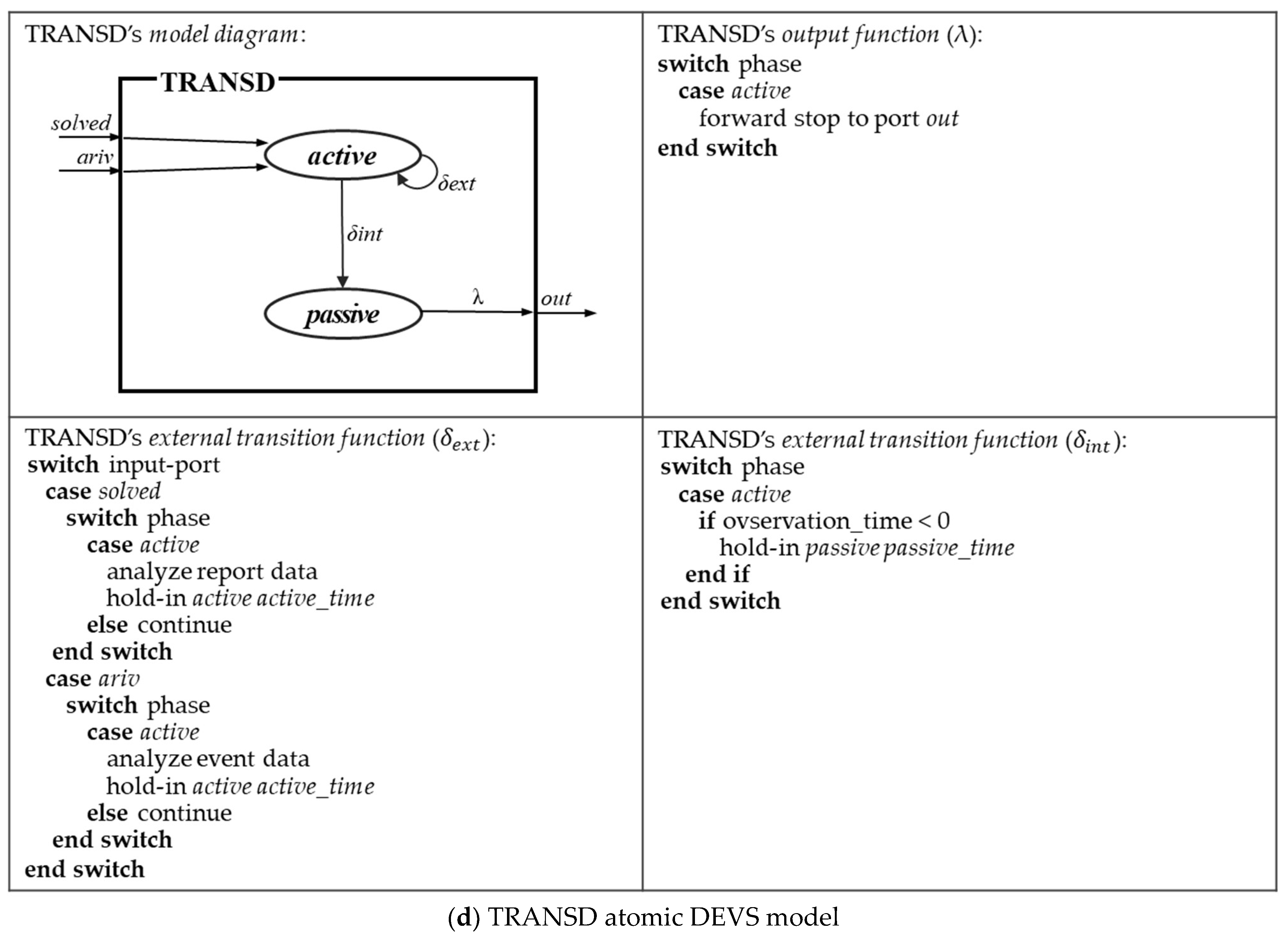
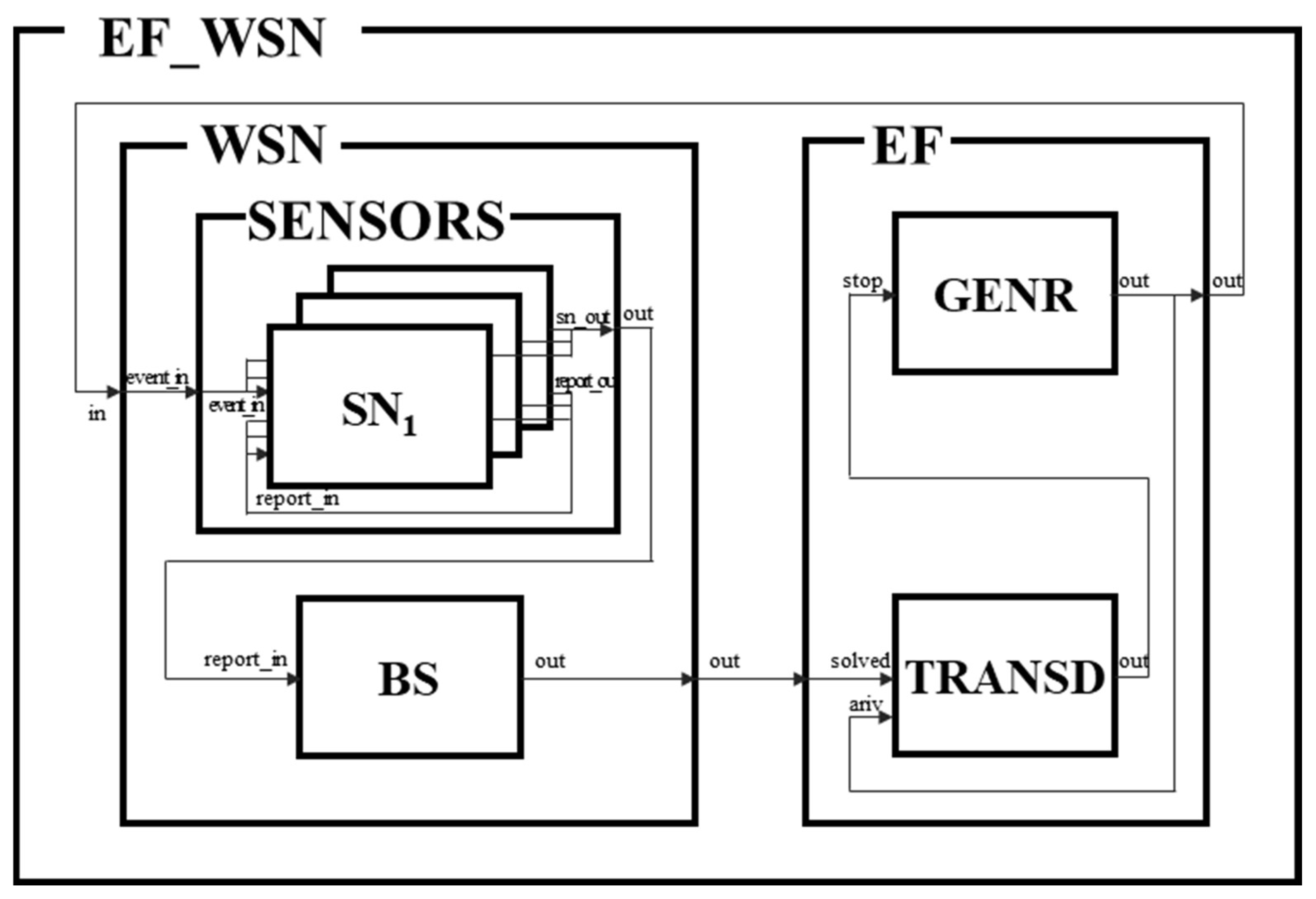
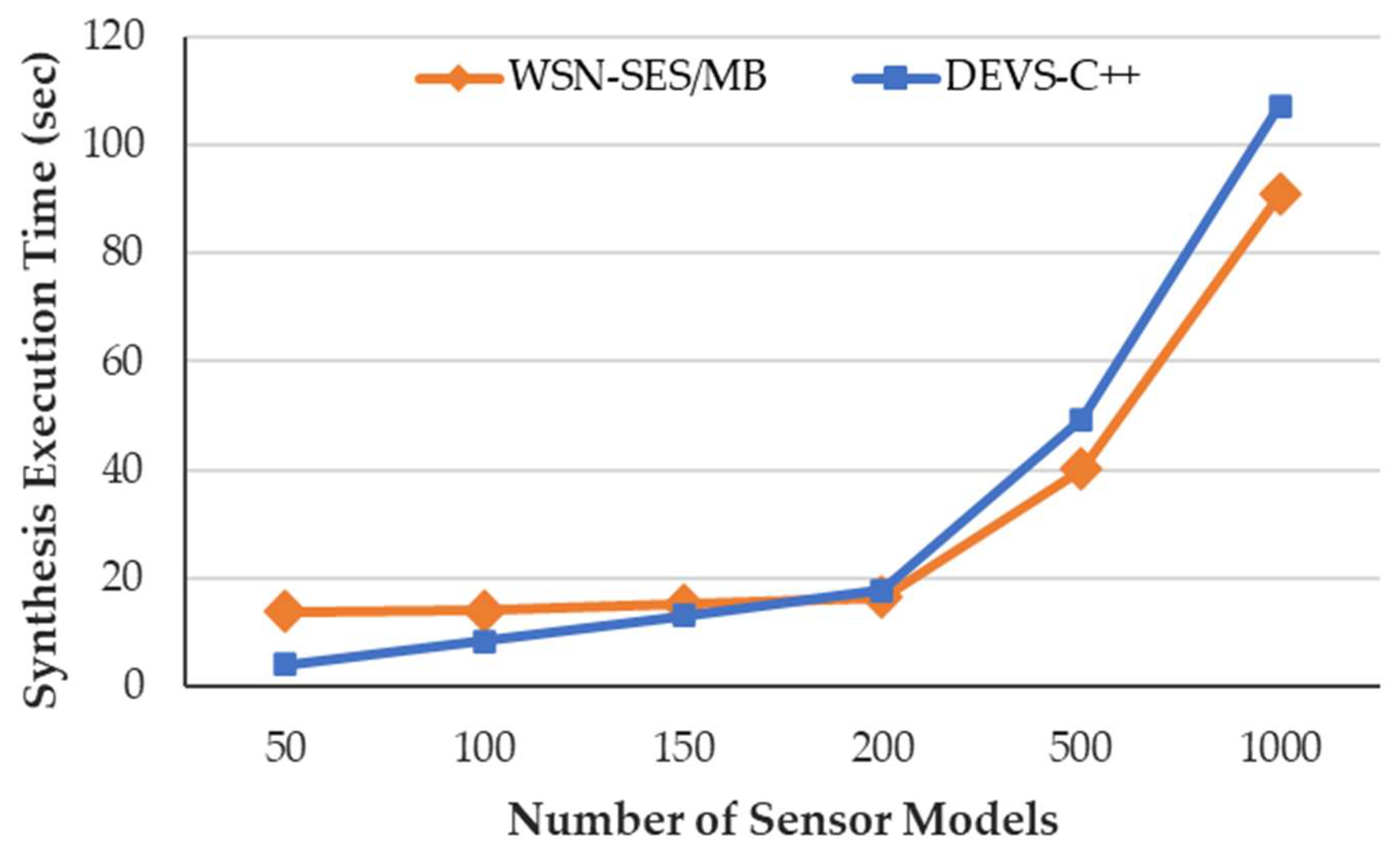
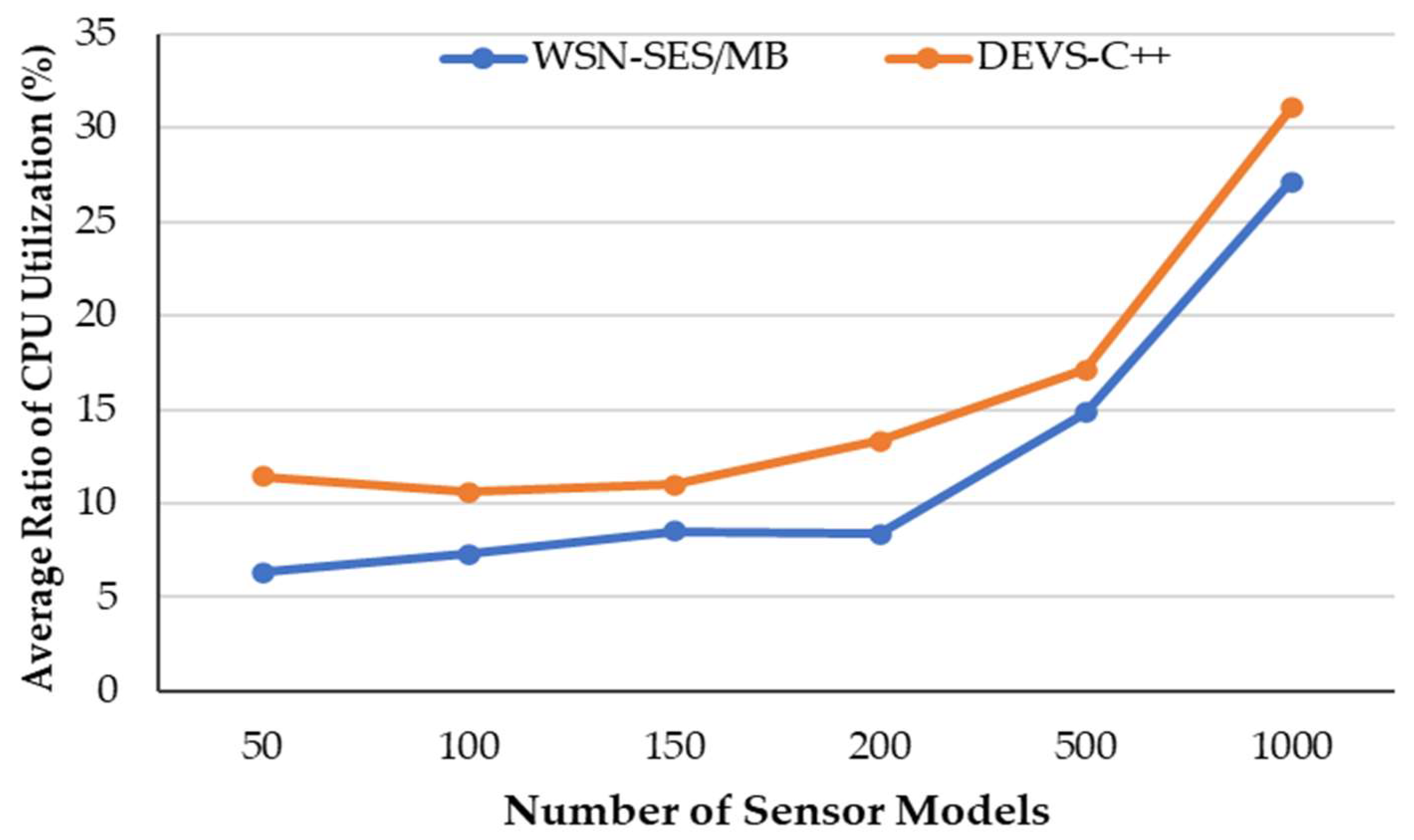
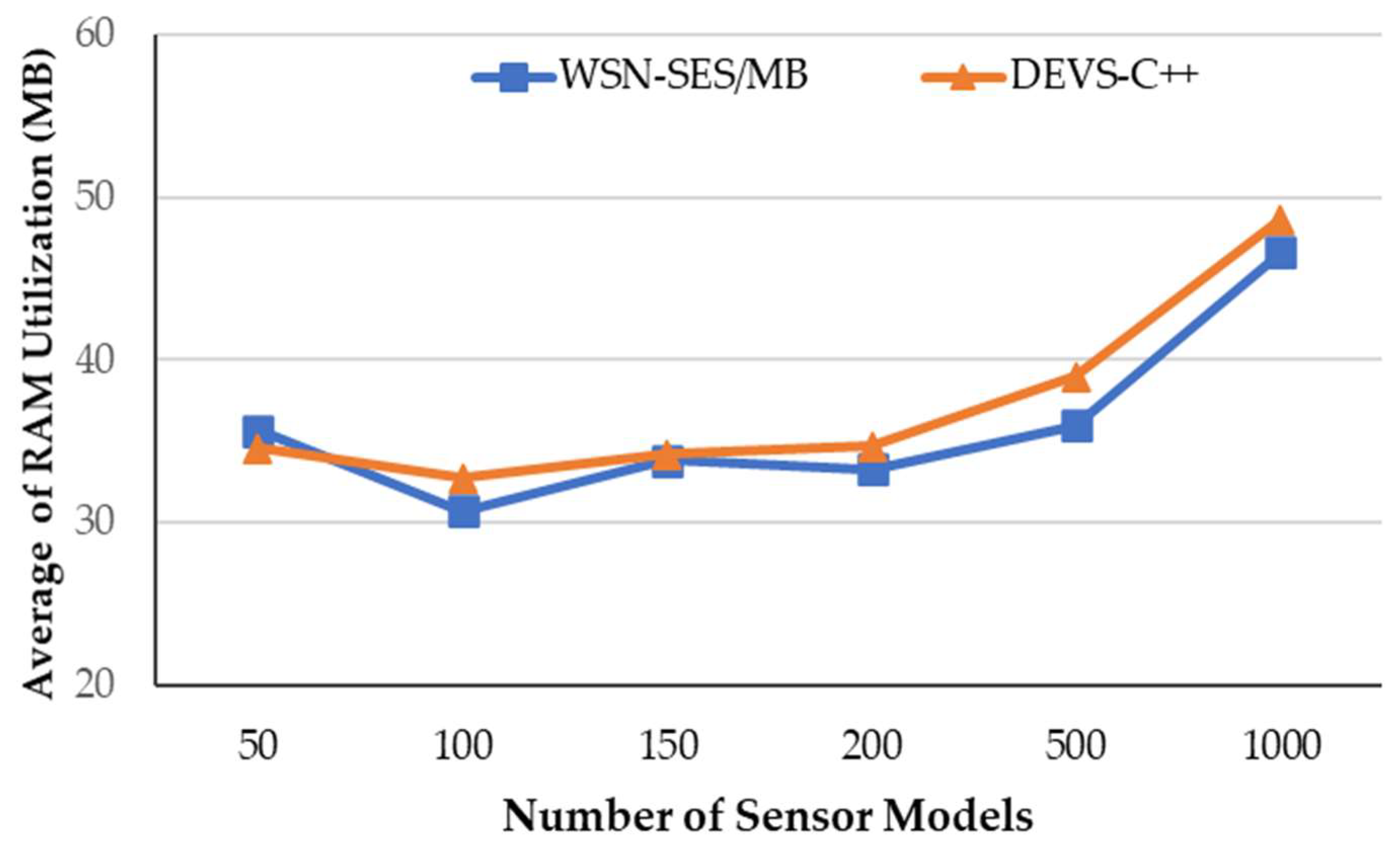
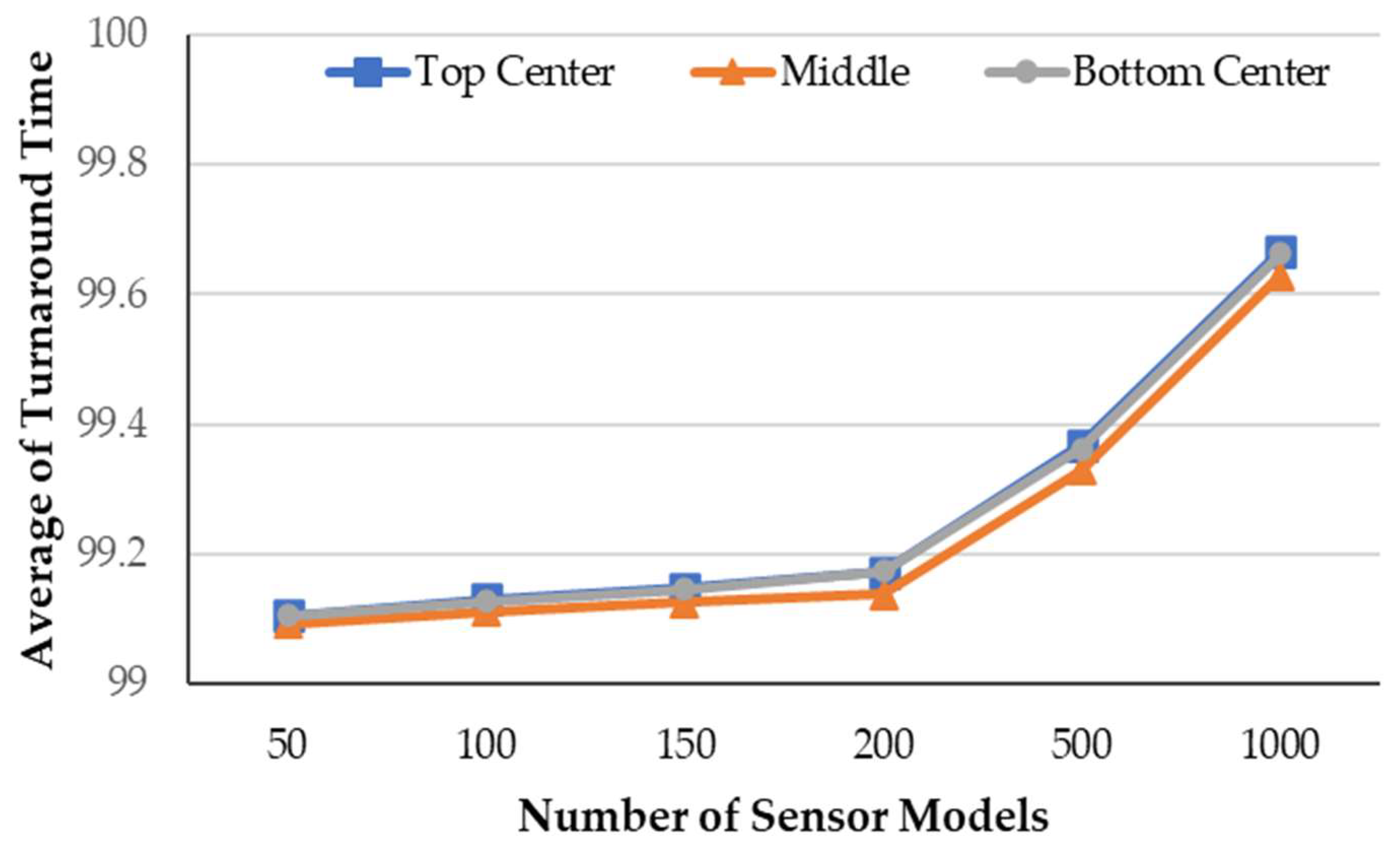
| No. | Simulator | Programming Language | Type | Characteristic | Automatic Model Synthesis | Limitations |
|---|---|---|---|---|---|---|
| 1 | Network Simulator-3 (NS-3) | C++ | Discreate-Event Simulation | General Simulator | No | Model Diversity and Reuse, Insufficient results and analysis methods |
| 2 | Objective Modular Network Testbed in C++ (OMNET++) | C++ | Discreate-Event Simulation | General Simulator | No | Model Diversity and Reuse, Insufficient results and analysis methods |
| 3 | TinyOS simulator (TOSSIM) | nesC | Discreate-Event Simulation | Specifically designed for WSNs | No | Only for TinyOS Code |
| 4 | probabilistic wireless network simulator (Prowler) | nesC | Discreate-Event Simulation | Specifically designed for WSNs | No | Probabilistic traffic, Insufficient results and analysis methods |
| 5 | simple NEST application simulator (Siesta) | nesC | Dynami Simulation | Specifically designed for WSNs | No | Only for TinyOS Code |
| 6 | Ashut | nesC | Discreate-Event Simulation | Specifically designed for WSNs | No | Only for TinyOS Code |
| 7 | routing modeling application simulation environment (Rmase) | nesC | Discreate-Event Simulation | Specifically designed for WSNs | No | Only for TinyOS Code |
| 8 | Sensor, environment and network simulator (SENS) | C++ | Discreate-Event Simulation | Specifically designed for WSNs | No | Model Diversity and Reuse |
| 9 | Fine-Grained Sensor Network Simulator (ATEMU) | nesC | Discreate-Event Simulation | Specifically designed for WSNs | No | Only for TinyOS Code |
| 10 | CupCarbon | Java | Discreate-Event Simulation | Specifically designed for WSNs | No | Model Diversity and Reuse, Insufficient results and analysis methods |
| 11 | DEVS-C++ | C++ | Discreate-Event Simulation | Specifically designed for WSNs | No | Manual synthesis |
| Number of Sensors | 50 | 100 | 150 | 200 | 500 | 1000 |
|---|---|---|---|---|---|---|
| Sensor of Field (m2) | 200 × 200 | 300 × 300 | 400 × 400 | 500 × 500 | 1000 × 1000 | 2000 × 2000 |
Publisher’s Note: MDPI stays neutral with regard to jurisdictional claims in published maps and institutional affiliations. |
© 2021 by the authors. Licensee MDPI, Basel, Switzerland. This article is an open access article distributed under the terms and conditions of the Creative Commons Attribution (CC BY) license (http://creativecommons.org/licenses/by/4.0/).
Share and Cite
Nam, S.M.; Kim, H.J. WSN-SES/MB: System Entity Structure and Model Base Framework for Large-Scale Wireless Sensor Networks. Sensors 2021, 21, 430. https://doi.org/10.3390/s21020430
Nam SM, Kim HJ. WSN-SES/MB: System Entity Structure and Model Base Framework for Large-Scale Wireless Sensor Networks. Sensors. 2021; 21(2):430. https://doi.org/10.3390/s21020430
Chicago/Turabian StyleNam, Su Man, and Hyung Jong Kim. 2021. "WSN-SES/MB: System Entity Structure and Model Base Framework for Large-Scale Wireless Sensor Networks" Sensors 21, no. 2: 430. https://doi.org/10.3390/s21020430






